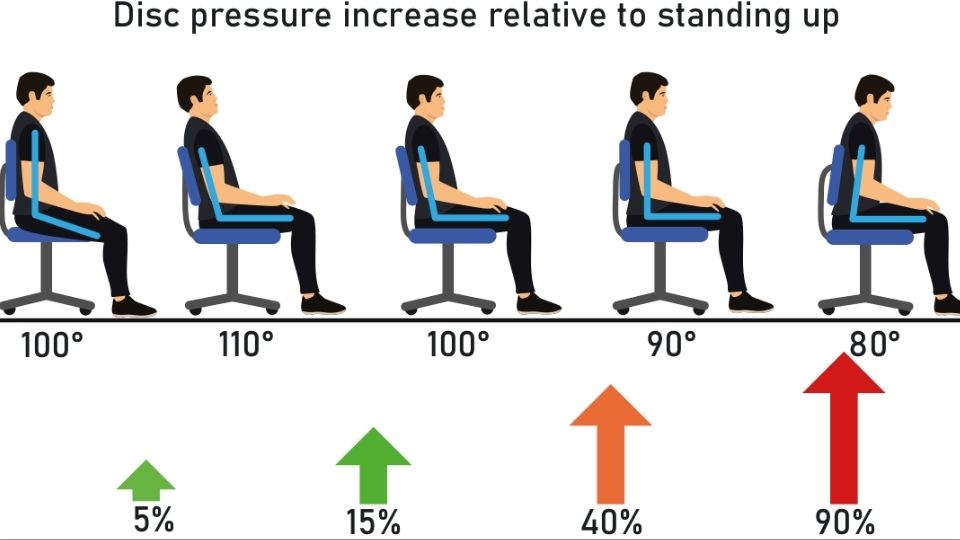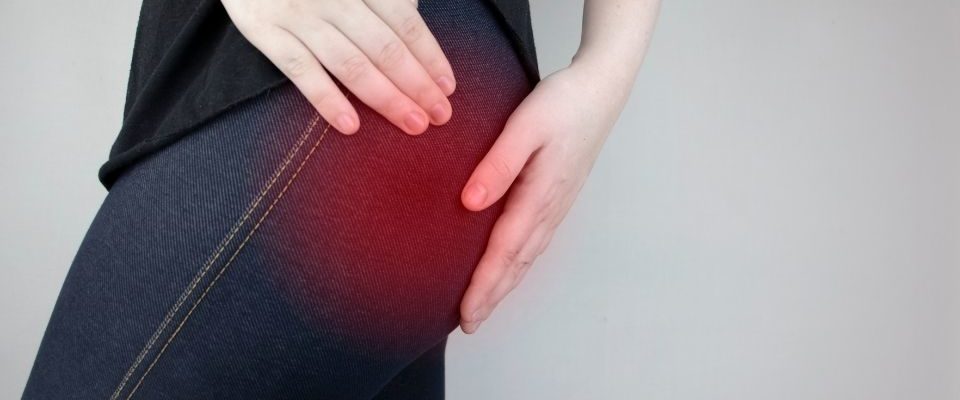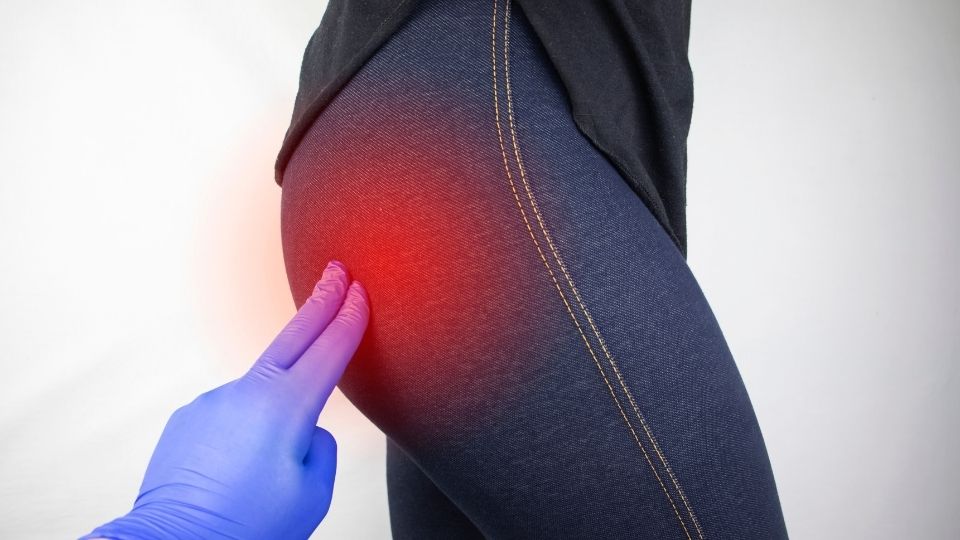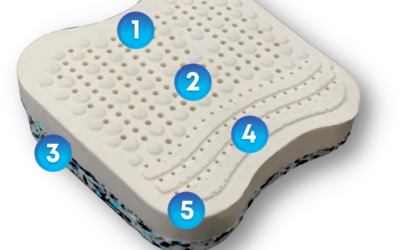Do you ever experience pain in your buttocks that seems to get worse at night? If so, you’re not alone. Buttock pain is a common problem, and there can be many causes. In this blog post, we’ll discuss some of the most common causes of buttock pain, and we’ll provide some tips on how to relieve the pain. Read on to learn more!
As a general rule, the most common cause of buttock pain at night is sciatica, which is a result of a herniated disc. Herniated discs may put pressure on the sciatic nerve, causing pain. Other possible causes of buttock pain at night include bursitis, arthritis, and muscle strain.
In my 30 years of Chiropractic practice, I have treated many patients with buttocks pain that occurs at night. In most cases, the pain is caused by poor posture and incorrect sleeping positions. I am also a trained ergonomist, and I have published a book on posture while sitting. I have +12K subscribers on a YouTube channel based on ergonomics, and TV appearances, and I had a successful Kickstarter campaign on posture-sitting devices. Based on my experience and expertise, I can help you figure out why you get buttocks pain at night, and I can provide you with some practical tips to improve your posture and reduce your pain.
Why Do I Have Buttock Pain at Night?
When lying on your back, the lower spine’s natural inward curve (called “lumbar lordosis”) is more accentuated than when sitting or reclining. This position reduces blood flow to muscles and nerves below it by narrowing down passageways where they exit out of the spinal column- which may cause sciatic nerve pain if you have a herniated disc or bone spur! Occasionally, a condition called ‘piriformis syndrome’ is one of the [causes] of low back/buttock pain with sciatica, most of which being prolapsed intervertebral disc. Individuals of all activity levels can be affected. Females are more affected than males.
How Do You Get Rid of Buttock Pain at Night?
Many people experience chronic buttock pain, which can be caused by a variety of factors. Some possible solutions for this condition include learning how to sit, stand, and sleep in proper alignment. This can help to reduce pressure on the glutes and minimize the risk of strain or injury. Additionally, getting quality sleep on a latex mattress can also help to provide cushioning and support for the body. If these strategies do not provide relief, another option is to use an ergonomic seat cushion while sitting or driving. With consistent use of any of these methods, you may find that your symptoms begin to subside over time. So if you’re looking to improve comfort, it’s worth exploring all the potential options available.
Make sure that you get your sitting right!
I explain the concept of my ergonomic design on a TV show HERE
When it comes to creating an ergonomic workstation, there are a number of important factors to keep in mind. First and foremost, you should be sure that your chair is properly adjusted to fit your body and support your back. This can be done in several ways, such as by adding an ergonomic seat cushion and lumbar support. These inserts can help to relieve pressure on your back and legs, allowing you to sit more comfortably for extended periods at the desk.
An ergonomic workstation is not only about having the right chair set up, but also ensuring that your feet are flat on the ground when you’re sitting at your desk. This will help keep your body aligned and reduce strain on your lower back and legs. Additionally, it’s important to make sure that there is adequate space between your chair, desk, and other office furniture. This space allows you freedom of movement while working so that you don’t feel cramped or restricted during long periods of typing or filing paperwork.
With these tips in mind, anyone can create a comfortable, healthy work environment for themselves. Whether at home or in a corporate office setting, prioritizing an ergonomic workstation will help ensure long-term comfort.
Best Seat Cushion for Buttock ComfortDoctor's Recommendation
Black Friday Offer!
Get 35% off Orthopedic Seat Cushion
Product DetailsResearch-based Design
Recommended ForBack Discomfort
Video Guide
Video Guide
Ergonomic Seat Cushion

Using an ergonomic seat wedge can be an effective way to improve posture and body alignment. This simple device helps to keep your spine aligned and prevent slouching, while also targeting your core muscles to improve balance and strength. Additionally, by keeping your body in a more upright position, the seat wedge can help to relieve tension in other areas of the body, such as the shoulders and neck. By achieving better posture overall, you can also enhance your comfort when sitting for long periods at a desk or computer. So whether you’re looking for healthier work habits or just looking to make everyday life a little more comfortable, using an ergonomic seat wedge is a smart choice that can make a difference.
Ergonomic Lumbar Support Cushion
- If you have ever experienced lower back pain, then you know how it can affect everyday tasks. But if you are looking for some relief, there is a simple solution: using ergonomic lumbar support. By choosing support made from natural latex and designed by an expert, you can give your lower back the support it needs. And with sturdy straps that hold your body in place, you will be able to move around more freely without worrying about causing any additional strain. So why not get started today? With the right lumbar support, you can improve your comfort. I’ve written a complete hands-on review about the best sitting position for sciatica, and here is what I tested best with my sciatica patients.
I was surprised how similar cheap memory foam seat cushions were on Aliexpress from the listing on Amazon!
Is Buttock Pain Serious?
The answer to this question depends on the type and severity of the pain. In general, buttock pain is not usually considered a serious health concern, unless it is accompanied by other symptoms such as loss of sensation or weakness in the legs. However, certain underlying conditions can cause buttock pain, including trauma injuries, sciatica, inflammatory diseases, or infections. If your buttock pain seems chronic or is accompanied by other unexplained symptoms, it’s best to talk to a doctor about your condition to get a proper diagnosis and appropriate treatment. With the right care and some rest and relaxation, you should be able to overcome this temporary ache and get back to enjoying life free from discomfort.
Black Friday: 35% Off Today
Typical Delivery 1-3 Days
Can Sitting Too Much Cause Buttock Pain?
Most people don’t think twice about sitting down. We do it to relax, to work, to watch TV, and even to sleep. But what many of us don’t realize is that sitting for long periods of time can actually be quite harmful to our health. One of the most common problems associated with excessive sitting is pain in the buttocks.
This is because the buttocks are designed for walking and standing, not for sitting. When we sit, the weight of our body is transferred to our buttocks, and over time this can lead to pain and discomfort. Additionally, sitting out of alignment can put additional strain on the muscles and joints, leading to even more pain. So if you’re suffering from buttock pain, it’s important to take a break from sitting as much as possible. And when you do sit, make sure that you’re doing so in a way that doesn’t exacerbate your pain.
If you are into super easy and inexpensive alternatives to office chairs, I wrote a fantastic article on how and why you should consider these options for back pain and I encourage you to read it!
How Should I Sleep with Piriformis Muscle Pain?
When you are experiencing piriformis muscle pain, one of the most important things to consider is how you sleep. There are certain sleeping positions that can help to ease your discomfort, while others can actually exacerbate your symptoms.
For example, if you are a side sleeper, an ergonomic neck pillow can be helpful in reducing pressure on your shoulders and spine. Additionally, placing a supportive pillow between your legs can also reduce pressure on your hip muscles by preventing them from pulling away from each other.
For back sleepers, the opposite approach may be best. In this case, a smaller neck pillow may be preferable to reduce strain on your spine and upper body. Additionally, placing a supportive pillow underneath the knees can provide relief for both the piriformis muscles and the nerves that extend down into your legs and feet. Ultimately, whether you are a side or back sleeper, the key is to find the right combination of pillows to support vulnerable areas like your hips and spine as you rest through the night. With these tips in mind, you can rest easy knowing that even when experiencing piriformis muscle pain, there are plenty of ways to get the high-quality sleep you need for optimal recovery.
Does Piriformis Syndrome Go Away?
Piriformis syndrome is a condition that affects the piriformis muscle. This muscle is located in the buttocks, and it helps to rotate the hip. When the piriformis muscle becomes tight or irritated, it can compress the sciatic nerve, leading to pain and other symptoms. Piriformis syndrome is often treated by correcting your sitting alignment and with stretching or massage. In some extremely rare cases, surgery may be necessary to release the pressure on the sciatic nerve. The good news is that, in most cases, piriformis syndrome will go away with treatment. However, it is important to seek chiropractic or physical therapy help if you are experiencing any pain or other symptoms. With proper diagnosis and treatment, you should be able to find relief from this condition.
How Do You Relieve Sciatic Nerve Pain in the Buttocks?

The sciatic nerve is the longest nerve in the human body, running from the lower back down the legs. When this nerve becomes compressed or irritated, it can cause pain in the lower back, buttocks, and legs. Sciatic nerve pain can range from mild to debilitating, and it can make it difficult to perform everyday activities. There are a number of ways to relieve sciatic nerve pain, including:
- Ergonomic seat cushion: These cushions provide support for your back and buttocks, helping you to sit up straighter and easing the pressure on your spine.
- Stretching exercises: Stretching the muscles that surround the sciatic nerve can help to relieve pressure on the nerve and reduce pain.
- Massage: Massaging the muscles in the affected area can help to loosen tight muscles and relieve pressure on the sciatic nerve.
- Heat therapy: Applying heat to the affected area can help to relax tense muscles and reduce inflammation.
- Ice therapy: Applying ice to the affected area can help to numb pain and reduce inflammation.
- Chiropractic care: Adjusting the spine can help to take pressure off of the sciatic nerve and relieve pain.
- Surgery: In some very rare cases, surgery may be necessary to remove a herniated disc or take pressure off of the sciatic nerve.
What Causes Hip and Buttock Pain?

Hip and buttock pain can be caused by a variety of factors. Generally, sitting and sleeping out of alignment is the most common culprit. This puts unnecessary strain on the muscles and joints in the area, leading to pain and stiffness. Additionally, poor posture can often lead to hip and buttock pain. When we slouch, the spine is not in proper alignment, which can cause the muscles and ligaments in the area to become overstretched and irritated. Additionally, carrying extra weight in the hips and buttocks can also lead to pain.
The added weight puts additional strain on the muscles and joints, which can lead to inflammation and discomfort. Thankfully, there are a number of ways to mitigate hip and buttock pain. Stretching and strengthening exercises can help to improve posture and alleviate muscle tension. Additionally, icing the area can help to reduce inflammation and pain. If you are experiencing hip or buttock pain, it is important to consult with a doctor or physical therapist to develop a treatment plan that is best for you.
What Does Piriformis Syndrome Pain Feel Like?

Piriformis syndrome is a painful condition that affects the deep muscles of the hip. Symptoms typically include deep and radiating pain in the buttocks, shooting pain down the leg, and muscle spasms. Often, people with piriformis syndrome experience sensations that are hard to describe or that vary from person to person.
For some, this pain may feel sharp or stabbing; for others, it may feel dull and achy like a constant ache in the gluteals. In addition, some people also experience muscle weakness or an inability to move their limbs freely. Regardless of how piriformis syndrome pain feels for each individual, one thing remains clear: this condition can be extremely debilitating, making it difficult to perform even everyday activities without significant discomfort.
Thankfully, however, there are a number of treatments available that can help to manage symptoms and restore quality of life. Whether you choose physical therapy or chiropractic care ensures that you get your sitting right!
Is Walking Good for Piriformis Syndrome?
In recent years, there has been an increased awareness of the health benefits of walking. This is due, in part, to research indicating that walking can help to prevent a number of chronic illnesses and conditions, such as high blood pressure, diabetes, and heart disease. One particular health condition that has been the focus of much attention is piriformis syndrome. This condition is caused by inflammation or abnormal growth of the piriformis muscle in the hip area, which can put pressure on the sciatic nerve and lead to pain and other symptoms. While some people have suggested that walking may exacerbate this syndrome, others have argued that regular walking can actually help to alleviate its symptoms.
On one side of the argument are those who believe that walking for long periods can worsen piriformis syndrome by causing further compression of the sciatic nerve. Research shows that the muscles of the hip and buttock play an important role in transmitting forces of the kinetic chain between the lower limb and torso, and injuries that hinder this force transmission have a detrimental effect on [walking].
However, some experts have shown that slow-paced walking at least three times per week can help to stretch out tight muscles and improve blood circulation around the hip area. Walking can also help to firm up key muscles in the lower body so that excessive strain does not put added pressure on these areas. Therefore, it seems clear from current research that walking is indeed good for those suffering from piriformis syndrome – as long as it is done in a safe, healthy manner.
How Do I Know If I Have Piriformis or Sciatica?
Sciatica is a condition that can cause pain in the lower back and legs. The pain is caused by pressure on the sciatic nerve, which runs from the lower back down the legs. Piriformis syndrome is a similar condition that occurs when the piriformis muscle, which is located in the buttocks, presses on the sciatic nerve. Both conditions can cause pain, numbness, and tingling in the legs. However, there are some key differences between the two conditions. Sciatica typically affects only one side of the body, while piriformis syndrome can affect both sides. In addition, sciatica is often worse when sitting or lying down, while Piriformis Syndrome may be worse when walking or standing. Finally, sciatica usually goes away on its own over time, while Piriformis Syndrome may require treatment with physical therapy or surgery. If you are experiencing pain in your lower back or legs, it is important to see a doctor to determine whether you have sciatica or piriformis syndrome.
What Is Bursitis of the Buttock?
Bursitis is a condition that causes inflammation of the bursa. The bursa is a fluid-filled sac that acts as a cushion between bones and tissues such as skin, tendons, and muscles. Bursitis often occurs in the shoulder, elbow, hip, or knee. However, it can also affect other joints, including the buttock.
Bursitis of the buttock is also known as trochanteric bursitis. It most often affects middle-aged and older adults. Women are also more likely to develop the condition than men. Trochanteric bursitis is usually caused by overuse or repetitive motion. This can happen from activities such as running or climbing stairs.
The condition can also be caused by an injury or direct hit to the buttock. Trochanteric bursitis can also occur as a result of arthritis or other inflammatory conditions. Symptoms of bursitis of the buttock include pain and tenderness around the affected joint, swelling, stiffness, and decreased range of motion. The pain is often worse with activity and at night. Treatment for bursitis of the buttock includes rest, ice, and elevating the affected area. Physical therapy may also be recommended to help stretch and strengthen the muscles around the joint. In some cases, corticosteroid injections or surgery may be necessary.
How Do I Prevent Piriformis Syndrome?
There are several things you can do to prevent piriformis syndrome. First, make sure to warm up before participating in any activities that may put a strain on your hips or buttocks. This includes stretching exercises that help to loosen up the muscles in these areas. Second, avoid activities that require you to sit for long periods of time, such as driving or working at a desk. If you must sit for extended periods, take frequent breaks to move around and stretch your legs. Third, exercise regularly to maintain strong muscles in your buttocks and hips. This will help to prevent excessive strain on these areas. Forth, get an ergonomic seat cushion to sit on if you drive or work at a desk for long periods of time. Fifth, if you have any preexisting conditions that may put a strain on your hips and buttocks, such as arthritis or herniated disc in the spine, make sure to take extra steps to avoid excessive strain in these areas. Finally, see a doctor right away if you experience any pain in your hips or buttocks. Early diagnosis and treatment are important in preventing piriformis syndrome from worsening.
As a caring chiropractor, I understand how debilitating buttock pain can be. Let’s explore some effective strategies to relieve your discomfort when sitting and lying down. Remember, it’s important to consult with a healthcare professional or reputable sources like Mayo Clinic or Cleveland Clinic for accurate and medically reviewed information on buttock pain and its potential causes.
Understanding Buttock Pain and Deep Gluteal Causes
Buttock pain can have various causes, such as muscle strain, nerve compression, injury, or underlying medical conditions. Identifying the root cause is crucial in finding the right relief methods for you. We can work together to determine the best course of action and find solutions tailored to your specific needs.
Managing Gluteal Syndrome when Sitting
To ease your discomfort while sitting, let’s make some adjustments to your sitting environment. Ergonomic modifications can make a significant difference. We’ll ensure you have a chair with proper lumbar support and adjustable features. Your feet should be flat on the ground, and your knees at a right angle to minimize strain on your buttocks. Additionally, we can explore the use of supportive cushions or pillows to enhance your sitting comfort.
Active Sitting Techniques and Regular Stretching
Sitting doesn’t have to be static and painful. We’ll explore active sitting techniques that engage your core muscles and promote an upright posture. By shifting your weight from one buttock to the other periodically, we can distribute pressure evenly. Incorporating regular stretching exercises and movement breaks will help relieve muscle tension and improve circulation. Together, we’ll create a plan that includes gentle stretches targeted at the buttock muscles, ensuring you find relief and comfort.
Relieving Butt Pain when Lying Down
Your comfort while lying down is just as important. Selecting the right mattress can greatly alleviate buttock pain. We’ll discuss optimal mattress options that offer both support and comfort. Reputable sources like Mayo Clinic or Cleveland Clinic can provide valuable guidance on mattresses designed to promote proper spinal alignment. Choosing a mattress made from high-quality materials will ensure your long-term well-being.
Finding the Right Sleep Positions and Support
The position you sleep in plays a vital role in relieving buttock pain. We’ll explore different sleep positions and find the one that works best for you. Placing a pillow between your knees while sleeping on your side can help maintain proper spinal alignment and reduce pressure on your buttocks. If sleeping on your back, a pillow under your knees may alleviate stress on the lower back and buttocks. Additionally, supportive pillows or cushions can be used to distribute weight evenly and reduce discomfort while lying down.
Identifying Potential Bone Cancer Symptoms
Although buttock pain is commonly caused by muscle strain or other non-serious factors, it’s important to be aware of potential bone cancer symptoms. If you experience persistent and severe buttock pain, particularly at night or during rest, it’s crucial to consult a healthcare professional. Look out for any additional symptoms like unexplained weight loss, fatigue, or neurological changes. They will provide a comprehensive evaluation and recommend appropriate diagnostic tests or treatments if necessary.
Promoting Overall Spinal Health and Well-being
In addition to relieving your butt pain, I’m committed to promoting your overall spinal health and well-being. We’ll work together to maintain good posture throughout your daily activities. I’ll guide you through strengthening and stretching exercises specifically targeting the muscles supporting your spine and buttocks. Additionally, adopting healthy lifestyle habits, such as regular exercise and a balanced diet, will contribute to your long-term well-being.
Remember, your comfort and health are my top priorities. By addressing your specific needs, incorporating professional guidance, and implementing effective strategies, we can work towards relieving your buttock pain and improving your quality of life
While there are many potential causes of buttock pain, it is important to seek professional attention if the pain persists. If you are experiencing buttock pain at night, make an appointment with your chiropractor or physical therapist to discuss your symptoms and find a treatment plan that works for you.
Sources:
- Sieper, J., van der Heijde, D.M.F.M., Landewe, R., Brandt, J., Burgos-Vagas, R., Collantes-Estevez, E., Dijkmans, B., Dougados, M., Khan, M.A., Leirisalo-Repo, M. and Van Der Linden, S., 2009. New criteria for inflammatory back pain in patients with chronic back pain: a real patient exercise by experts from the Assessment of SpondyloArthritis international Society (ASAS)/ What the causes are. Annals of the rheumatic diseases, 68(6), pp.784-788.
- Arnbak, B., Jurik, A.G., Jensen, T.S. and Manniche, C., 2018. Association between inflammatory back pain characteristics and magnetic resonance imaging will have findings in the spine and sacroiliac joints. Arthritis care & research, 70(2), pp.244-251.
- Sadreddini, S., Noshad, H., Molaeefard, M., Ardalan, M.R., Ghojazadeh, M. and Shakouri, S.K., 2009. Unguided sacroiliac injection: effect on refractory buttock pain in patients with spondyloarthropathies. La Presse Médicale, 38(5), pp.710-716.
- Hamilton, L., Macgregor, A., Warmington, V., Pinch, E. and Gaffney, K., 2014. The prevalence of inflammatory back pain in a UK primary care population. Rheumatology, 53(1), pp.161-164.
- Singh, U.S., Meena, R.K., Singh, C.A.K., Singh, A.J., Singh, A.M. and Langshong, R., 2013. Prevalence of piriformis syndrome among the causes pain of low back/buttock pain with sciatica: A prospective study. Journal of Medical Society, 27(2), p.94.
- Vasudevan, J.M., Smuck, M. and Fredericson, M., 2012. Evaluation of the athlete with buttock pain. Current Sports Medicine Reports, 11(1), pp.35-42. deep gluteal syndrome
- Aaron, D.L., Patel, A., Kayiaros, S. and Calfee, R., 2011. Four common types of bursitis: diagnosis and management. JAAOS-Journal of the American Academy of Orthopaedic Surgeons, 19(6), pp.359-367.
- Foster, M.R., 2002. Piriformis syndrome. Orthopedics, 25(8), pp.821-825. mayoclinic org
- Frymoyer, J.W., 1988. Back pain and sciatica. (causes of pain) New England Journal of Medicine, 318(5), pp.291-300.














